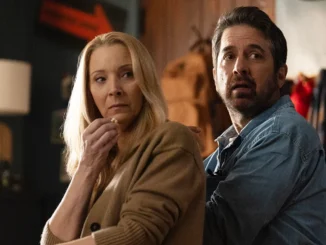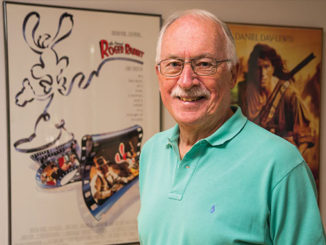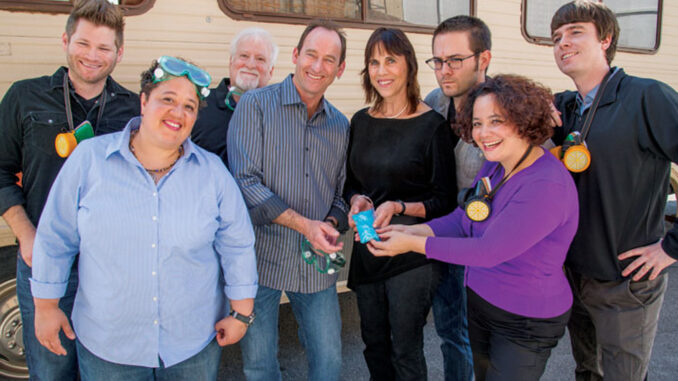
by Sharidan Williams-Sotelo • portraits by Wm. Stetz
“Chemistry is…well, technically, it’s the study of matter. But I prefer to see it as the study of change…the cycle. Solution, dissolution, over and over.” – Walter White
Allow me to introduce you to the post-production alchemy that produces the show that, according to Newsweek senior writer Andrew Romano, is “right now…the best program on TV, period.” April 5 of 2013 was the last day of receiving film dailies (yes, we still shoot on film) on the landmark AMC/Sony Television series, Breaking Bad. This date happened to fall on my birthday and, as a member of the editorial ensemble since season two, I celebrated the occasion in Br-Ba fashion by forming my Denny’s Grand Slam bacon slices into the numbers of my age. According to Lynne Willingham, ACE, the editor of the series’ pilot, the famous birthday fake-bacon scene was in fact the first scene that she cut on Breaking Bad. As my gratifying stint on this is approaching an end, I feel compelled to recall the origins of my “bacon-salad” days with Breaking Bad editorial.
Lynne met and worked with writer-producer Vince Gilligan on The X-Files. A nucleus was formed between them and, years later, Vince would ask Lynne to cut the pilot of his new show for AMC. Her assistant, Kelley Dixon, ACE, encouraged Lynne to take on the bold project about a chemistry teacher who is diagnosed with lung cancer and decides that cooking methamphetamine would be a good way to provide support for his family after he’s gone.
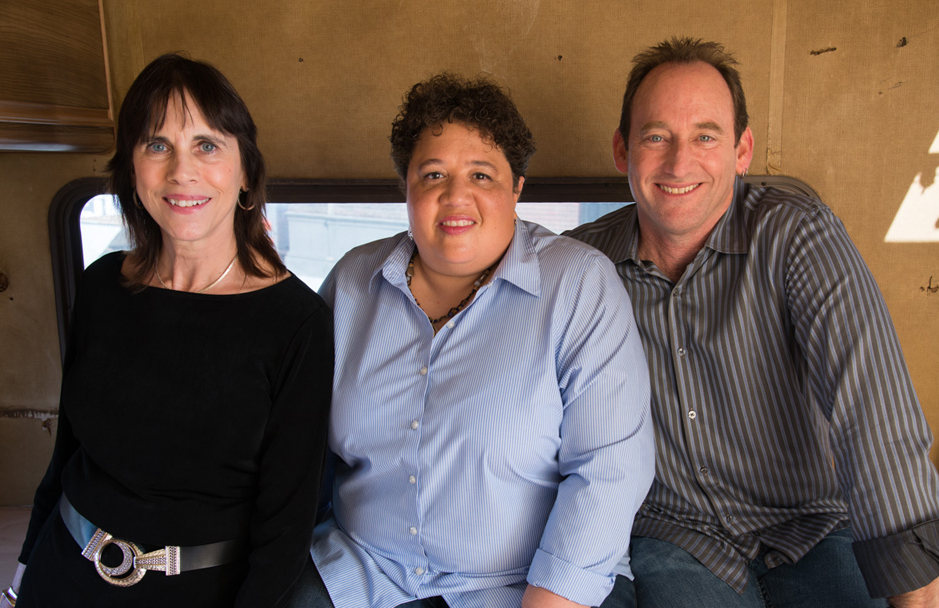
Together, Lynne and Kelley labored to create the special chemistry that made the Breaking Bad pilot the edgy, gripping concoction that Vince had imagined. Kelley worked with Lynne not only as her assistant, but as her “lab partner,” helping to cook up montages and shape the editorial sensibilities of the show. For Kelley’s efforts, she was bumped up to full editor status for season one of the series.
The Periodic Table of Elements
Season one’s editorial structure was an experiment in trying to get the flow of the cutting room just right. As one of two pioneering shows on a network that was just breaking into original scripted programming (the other being Mad Men), the first season’s shows were highly ambitious and time-consuming. To ease the pressure of the schedule, a third editorial proton, Skip Macdonald, ACE, was added to the compound. Although Skip has a mild demeanor, his first episode culminated in an explosion of fulminated mercury — proving that a calm element is needed to produce a storm.
But then, in the throes of season one, the Writers Guild of America strike of 2008 brought production to a screeching halt, forcing the show to go in a different direction and, in the process, changing the chemical make-up of Br-Ba editorial.
To ride out the strike, Lynne and Kelley moved on to an anthology series for NBC titled Fear Itself. I had just started working there as an assistant editor to Randy Jon Morgan, ACE, and that is where I met Lynne and Kelley. At the end of the run of Fear, they asked Randy for his permission to steal me away from him, and take me along as they went back to resume working on Breaking Bad for its second season.
Lynne asked Mel Friedman to join the crew as an assistant editor, having worked with him previously on The Guardian. Mel agreed, completing the editorial elements for season two.
Breaking Bad’s process and success is built around the massive talent and generosity of Vince, our showrunner. As with every job, the work environment is generated from the top and is reflected in the attitude and dedication of the crew. And Vince’s leadership inspires enthusiasm in all members of the crew. Simply put, virtually everyone who works on Br-Ba is also an avid fan of the show.
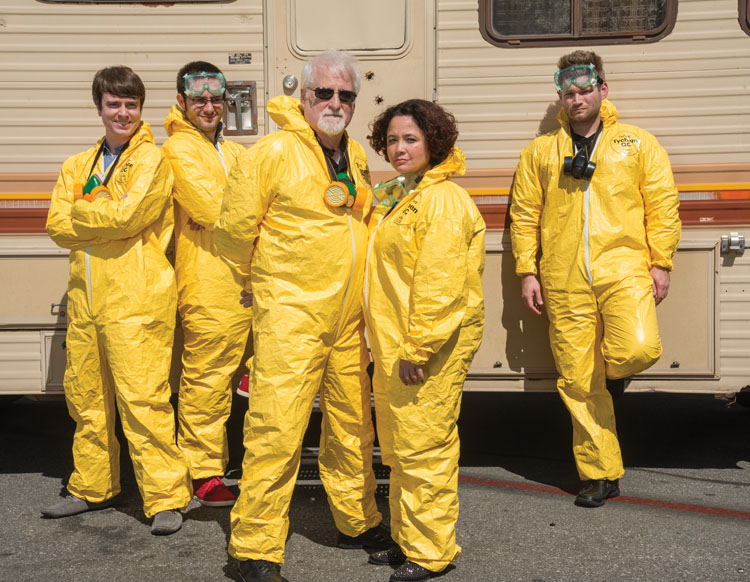
Season three brought more changes to the crew as Lynne left to work on True Blood. As a result, Kelley and Skip went on a two-two rotation that only worked out because our schedule is not up against airdates; we do not have to complete shows with our next episode breathing down our necks as heavily as we would on a broadcast network. We can take more time to massage the cuts without the pressure of the usual television schedule.
Producer Diane Mercer, who brings to Br-Ba her wealth of experience, including running post on Arrested Development, heads up our post-production department. Associate producer Andrew Ortner has been part of Breaking Bad since season one and, along with Kelley, could probably curate a museum of fan art and memorabilia from the show.
Together, they keep the post machine as well greased as the fried chicken served at Los Pollos Hermanos, the infamous chicken joint from our show. Gina Scheerer, our associate producer in season one, started a tradition of respect for the editorial department, and this congeniality continues under the leadership of Diane and Andrew to this day.
Substance, Molecules and Bonds
Mel and I are acutely aware that the writing of Breaking Bad has been one of the most crucial factors in the success of the show. We are both writers in our own right — Mel penned the original screenplays for Running Man, Bloodsport and others, and I have authored a children’s book and recently optioned my first screenplay — and have a deep appreciation of how uniquely special the scripts are. I’ve never been in another cutting room where everyone in editorial rushes to read the outlines of new episodes, and continues chomping at the bit for the minute these ideas become the final script. In the marriage of writing and editing, it is no surprise that story analysts are part of our Guild. Editors are audio-visual storytellers, and that is evident on a daily basis on the job at Breaking Bad; our editors are free to tell the tale of Walter White and his arc from Mr. Chips to Scarface.
Coming up as editing rooms went from Moviolas and KEMs to the high-tech world of modern editing facilities, Mel and I knew how to blend the skills of current technology with the organizational principles that have always been a fundamental part of a traditional film cutting room. We still operate on Avid 4.0.5 with Unity, because it works for us, and we have the continuous stellar support from our technical team at Timeline Rentals, headed by David Amado. With their attention and outstanding care, we are able to work without worry.
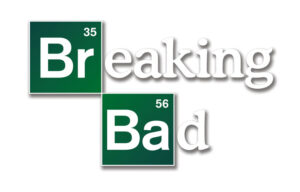 Rounding out the post-production roster are a number of coordinators, post assistants and interns who’ve learned the old-school cutting-room process from Mel and me. Both of us have worked on major features and television shows, working with the likes of Michael Kahn, ACE, Frank Urioste, ACE, Stuart Baird, ACE, Michael Knue, ACE, Bob Ferretti, ACE and Bob Lambert, ACE, to mention a few. Through our experiences with those luminaries, we learned the fundamentals in setting up the editorial workflow to maximize what matters: the storytelling of the series.
Rounding out the post-production roster are a number of coordinators, post assistants and interns who’ve learned the old-school cutting-room process from Mel and me. Both of us have worked on major features and television shows, working with the likes of Michael Kahn, ACE, Frank Urioste, ACE, Stuart Baird, ACE, Michael Knue, ACE, Bob Ferretti, ACE and Bob Lambert, ACE, to mention a few. Through our experiences with those luminaries, we learned the fundamentals in setting up the editorial workflow to maximize what matters: the storytelling of the series.
The Scientific Method
In today’s world of temporary tracks gone crazy, it is worth noting that when we send a cut to the studio and network for viewing, it is without a temporary score to influence or intrude on the story. The only music that we include accompanies scripted montages. It is Breaking Bad’s approach to turn over a cut without temporary music; it’s a style that has worked for our show, and allows our sound and music department more freedom to make their own award-winning contributions.
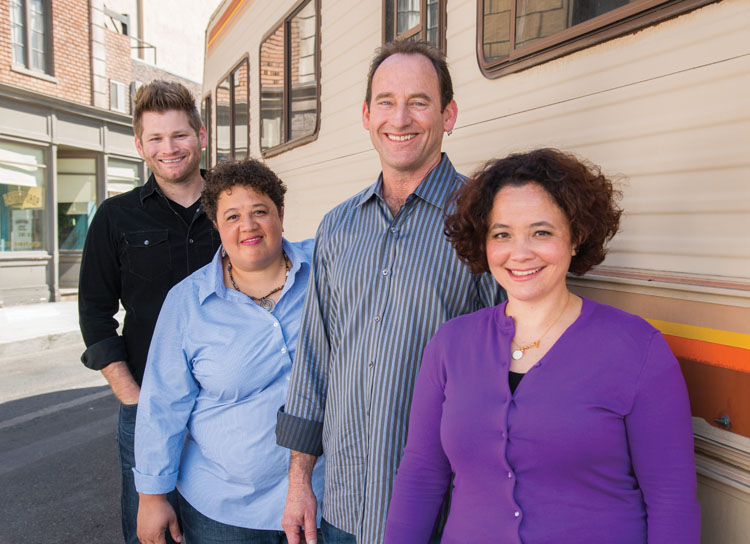
The music team consists of our composer David Porter, music supervisor Thomas Golubic, and music editor Jason Tregoe Newman. Our sound supervisor Nick Forshager, dialogue editor Jane Boegel, sound effects editor Mark Cookson, Foley artist Gregg Barbanell, assistant sound editor Jeff Cranford and additional dialogue recording supervisor Kathryn Madsen complete the team of editing professionals contributing to the final air version of Breaking Bad.
As the sound department, joined by re-recording mixers Jeffrey Perkins and Eric Justen, must mix one episode per week, thoughtful prep of the work tracks by the picture editing teams is essential. And since we are not constantly guessing about the temporary music to score a scene, we can handcraft a solid temporary work track in the Avid for Nick and his crew to use as a basis for their fine work.
Season four was the last season that Breaking Bad was still a relatively low-profile show. Previously, when I told people what show I was working on, as often as not they would have a puzzled look on their face. But by season four, I had friends far removed from the industry become extremely excited when I told them I worked on Breaking Bad.
One element that shook up the landscape came near the end of season four: The definite end to the series was announced; there would only be 16 more episodes, with season five split into two subsets of eight episodes each (A and B), what I call “semesters.” Indeed, the “senior year” of the Breaking Bad school was coming, and graduation was imminent.
With the upsurge of interest, different protocols became required. Confidentiality entered into our everyday work environment to protect Walter White’s empire. Season five also took our cutting room from standard definition to high definition, another big change, especially since our show incorporates flashbacks, flash-forwards and time-lapse footage, not to mention our sound effects library that had been imported over the years. All of this material would require conversion. So from 14:1 omf media files to DNX36 MXF files we went, and eventually the morning ritual of digitizing dailies morphed into the new procedure of copying files from drives. Not to say we were antiquated, but the philosophy of what makes our editorial process on Br-Ba click is that we didn’t get the latest versions of tools simply to have new bells and whistles.
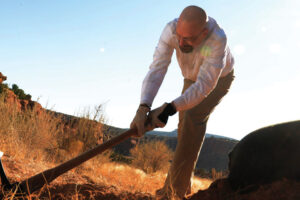
Photo by Ursula Coyote/AMC
We respect the technology like Walter White respects the chemistry: The advancement of equipment in the cutting room should be organic to the nature of the storytelling. If the storylines and style of the show necessitate a more current version of the software, then it will be incorporated into our system. But for the needs of Breaking Bad, having the most stable combination of operating system — Unity — and Avid version recommended by our techs at Timeline was our main criterion and modus operandi.
In season five B, our final “semester,” we also marked some changes in personnel. Mel retired from the show, and Kelley brought in her assistant from another job, Chris McCaleb. Alecia Weaver came aboard for the post assistant position.
It is interesting for me to see the dynamics of the cutting room change with new players, and how the injection of two huge fans of Breaking Bad into our formula gels with the original elements. So far, the results have all been positive, continuing to refresh the energy of the show.
The Alchemy of Accolades
Our cutting room has created a chemical reaction — lightning in a bottle that has garnered our picture and sound editorial team two Emmy awards and seven additional nominations, four ACE Eddie Awards and nine additional nominations, as well as several other honors, all while creating some of the most iconic moments in cable television. Skip and Kelley were also invited to join the prestigious American Cinema Editors during their tenure.
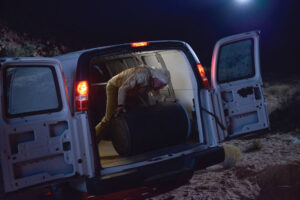
Photo by Ursula Coyote/AMC
It is a rare treat to receive so much recognition for our editing talent, hard work and chemistry, but that is the magic result that comes from contributing to a show of Breaking Bad’s caliber. I am proud to join Skip in a co-editing credit this season with a temporary bump up, continuing the cycle of mentoring and fellowship that originated with Lynne and Kelley on the pilot.
My life in Breaking Bad editorial can be broken down as a study of our elemental particles — professional, skilled people blending their talents and helping to create well-crafted stories that matter.
I will admit it. I am addicted to the cycle. To the chemistry. I know it will be a hard habit to break.


